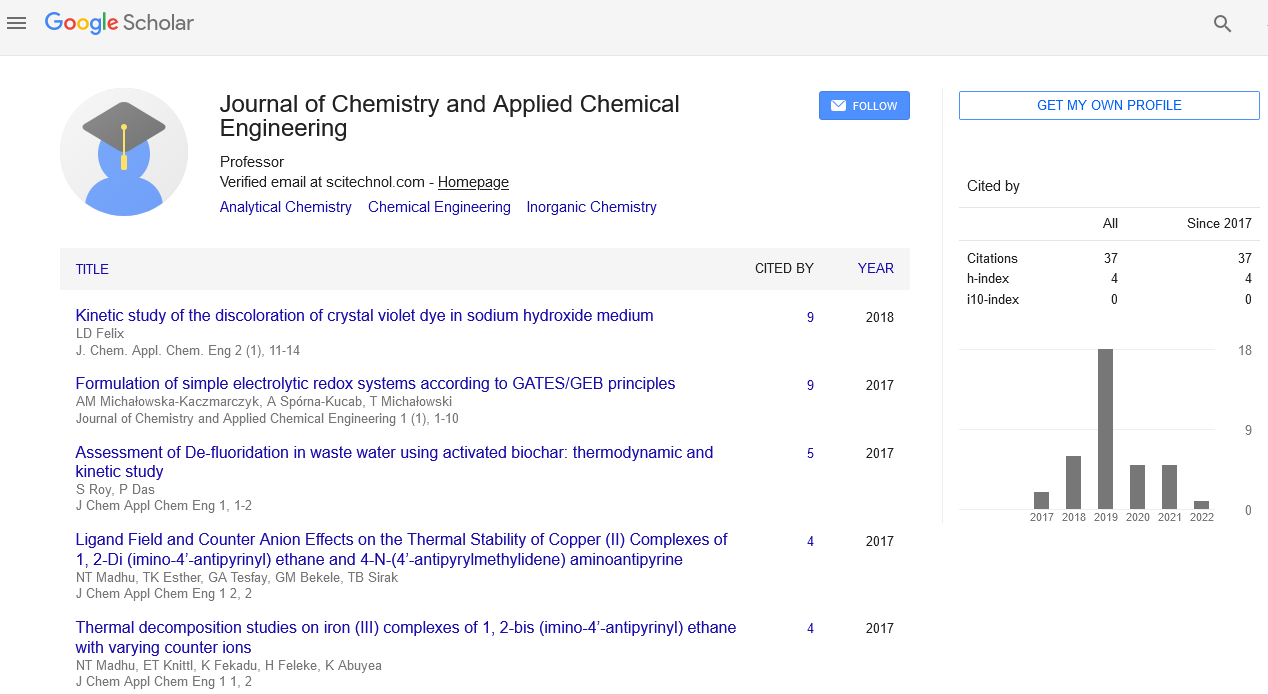Short Communication, J Chem Appl Chem Eng Vol: 7 Issue: 1
Rational Design of Nanomaterials for Energy Storage and Conversion
James Michael*
Department of Materials Science and Chemical Engineering, Stony Brook University, Stony Brook, USA
*Corresponding Author: James Michael
Department of Materials Science and
Chemical Engineering, Stony Brook University, Stony Brook, USA
E-mail: j.michael@89.edu
Received date: 28 February, 2023, Manuscript No. JCACE-23-95550;
Editor assigned date: 03 March, 2023, Pre QC No. JCACE23-95550(PQ);
Reviewed date: 17 March, 2023, QC No. JCACE-23-95550;
Revised date: 24 March, 2023, Manuscript No. JCACE-23-95550 (R);
Published date: 31 March, 2023, DOI: 10.4172/Jcace.1000e021
Citation: Michael J (2023) Rational Design of Nanomaterials for Energy Storage and Conversion. J Chem Appl Chem Eng 7:1.
Description
Nanomaterials have emerged as potential particles for energy storage and conversion applications due to their unique physical and chemical properties. The rational design of nanomaterials for these applications involves tailoring their structure, composition, and properties at the nanoscale to optimize their performance. This paper will discuss the rational design of nanomaterials for energy storage and conversion, including their synthesis, characterization, and performance evaluation.
Energy storage and conversion applications include batteries, supercapacitors, fuel cells, and solar cells. Nanomaterials are particularly attractive for these applications due to their high surface area-to-volume ratio, short diffusion lengths, and tunable electronic and optical properties. However, the performance of nanomaterials in energy storage and conversion depends on several factors, including their size, shape, crystal structure, surface chemistry, and morphology.
The synthesis of nanomaterials can be achieved through various methods, such as chemical vapor deposition, sol-gel, hydrothermal synthesis, and electrodeposition. The choice of synthesis method depends on the desired properties of the nanomaterials and the specific application. For example, sol-gel and hydrothermal synthesis methods can produce well-defined nanoparticles with controlled size and shape, while chemical vapor deposition can produce thin films with high surface area-to-volume ratios.
Characterization of nanomaterials is essential to understand their structure and properties at the nanoscale. Techniques such as Transmission Electron Microscopy (TEM), Scanning Electron Microscopy (SEM), X-Ray Diffraction (XRD), and Fourier-Transform Infrared Spectroscopy (FTIR) can provide information on the size, shape, crystal structure, and surface chemistry of nanomaterials.
The performance evaluation of nanomaterials for energy storage and conversion involves measuring their electrical and electrochemical properties, such as capacitance, conductivity, and charge/discharge rates. These properties can be measured using techniques such as cyclic voltammetry, electrochemical impedance spectroscopy, and galvanostatic charge/discharge measurements.
One example of the rational design of nanomaterials for energy storage is the development of nanostructured electrodes for supercapacitors. Supercapacitors are energy storage devices that can deliver high power densities and long cycle life. Nanostructured electrodes can increase the surface area and shorten the diffusion length of charge carriers, resulting in higher capacitance and faster charge/discharge rates.
Another example is the design of nanomaterials for solar cell applications. Solar cells convert sunlight into electrical energy by absorbing photons and generating electron-hole pairs. Nanomaterials can be used as light absorbers, electron acceptors, and electron donors in solar cells. For example, semiconductor nanoparticles such as CdS, CdSe, and TiO2 have been used as electron acceptors in dye-sensitized solar cells.
Nanomaterials can also be used in fuel cells, which convert chemical energy into electrical energy by oxidizing fuels such as hydrogen, methanol, or ethanol. Nanomaterials can be used as catalysts, electrolytes, and support materials in fuel cells. For example, Pt nanoparticles supported on carbon nanotubes have been used as catalysts in proton exchange membrane fuel cells.
The rational design of nanomaterials for energy storage and conversion involves tailoring their structure, composition, and properties at the nanoscale to optimize their performance. The synthesis, characterization, and performance evaluation of nanomaterials are essential steps in the design process. Nanomaterials have the potential to revolutionize energy storage and conversion technologies, and their development is an exciting area of research with significant practical implications.
 Spanish
Spanish  Chinese
Chinese  Russian
Russian  German
German  French
French  Japanese
Japanese  Portuguese
Portuguese  Hindi
Hindi 